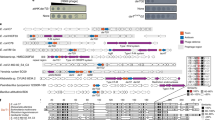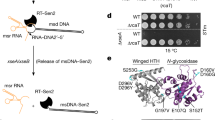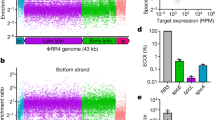Abstract
The ≥1030 bacteriophages on Earth relentlessly drive adaptive coevolution, forcing the generation of protective mechanisms in their bacterial hosts. One such bacterial phage-resistance system, ToxIN, consists of a protein toxin (ToxN) that is inhibited in vivo by a specific RNA antitoxin (ToxI); however, the mechanisms for this toxicity and inhibition have not been defined. Here we present the crystal structure of the ToxN–ToxI complex from Pectobacterium atrosepticum, determined to 2.75-Å resolution. ToxI is a 36-nucleotide noncoding RNA pseudoknot, and three ToxI monomers bind to three ToxN monomers to generate a trimeric ToxN–ToxI complex. Assembly of this complex is mediated entirely through extensive RNA-protein interactions. Furthermore, a 2′-3′ cyclic phosphate at the 3′ end of ToxI, and catalytic residues, identify ToxN as an endoRNase that processes ToxI from a repetitive precursor but is regulated by its own catalytic product.
This is a preview of subscription content, access via your institution
Access options
Subscribe to this journal
Receive 12 print issues and online access
$189.00 per year
only $15.75 per issue
Buy this article
- Purchase on Springer Link
- Instant access to full article PDF
Prices may be subject to local taxes which are calculated during checkout






Similar content being viewed by others
Change history
28 January 2011
In the version of this article initially published online, there was a mistake in the cell dimension values in row 3 of Table 1 (SeMet). These should read 182.85, 118.13, 41.90. The error has been corrected in all versions of the article.
References
Wommack, K.E. & Colwell, R.R. Virioplankton: viruses in aquatic ecosystems. Microbiol. Mol. Biol. Rev. 64, 69–114 (2000).
Lima-Mendez, G., Toussaint, A. & Leplae, R. Analysis of the phage sequence space: the benefit of structured information. Virology 365, 241–249 (2007).
Labrie, S.J., Samson, J.E. & Moineau, S. Bacteriophage resistance mechanisms. Nat. Rev. Microbiol. 8, 317–327 (2010).
Chopin, M.C., Chopin, A. & Bidnenko, E. Phage abortive infection in lactococci: variations on a theme. Curr. Opin. Microbiol. 8, 473–479 (2005).
Shub, D.A. Bacterial viruses. Bacterial altruism? Curr. Biol. 4, 555–556 (1994).
Fineran, P.C. et al. The phage abortive infection system, ToxIN, functions as a protein-RNA toxin-antitoxin pair. Proc. Natl. Acad. Sci. USA 106, 894–899 (2009).
Blower, T.R. et al. Mutagenesis and functional characterization of the RNA and protein components of the toxIN abortive infection and toxin-antitoxin locus of Erwinia. J. Bacteriol. 191, 6029–6039 (2009).
Pandey, D.P. & Gerdes, K. Toxin-antitoxin loci are highly abundant in free-living but lost from host-associated prokaryotes. Nucleic Acids Res. 33, 966–976 (2005).
Hayes, F. Toxins-antitoxins: plasmid maintenance, programmed cell death, and cell cycle arrest. Science 301, 1496–1499 (2003).
Gerdes, K., Christensen, S.K. & Lobner-Olesen, A. Prokaryotic toxin-antitoxin stress response loci. Nat. Rev. Microbiol. 3, 371–382 (2005).
Keren, I. et al. Specialized persister cells and the mechanism of multidrug tolerance in Escherichia coli. J. Bacteriol. 186, 8172–8180 (2004).
Gerdes, K., Rasmussen, P.B. & Molin, S. Unique type of plasmid maintenance function: postsegregational killing of plasmid-free cells. Proc. Natl. Acad. Sci. USA 83, 3116–3120 (1986).
Gerdes, K. & Wagner, E.G. RNA antitoxins. Curr. Opin. Microbiol. 10, 117–124 (2007).
Hargreaves, D. et al. Structural and functional analysis of the Kid toxin protein from E. coli plasmid R1. Structure 10, 1425–1433 (2002).
Jørgensen, M.G., Pandey, D.P., Jaskolska, M. & Gerdes, K. HicA of Escherichia coli defines a novel family of translation-independent mRNA interferases in bacteria and archaea. J. Bacteriol. 191, 1191–1199 (2009).
Miallau, L. et al. Structure and proposed activity of a member of the VapBC family of toxin-antitoxin systems. VapBC-5 from Mycobacterium tuberculosis. J. Biol. Chem. 284, 276–283 (2009).
Neubauer, C. et al. The structural basis for mRNA recognition and cleavage by the ribosome-dependent endonuclease RelE. Cell 139, 1084–1095 (2009).
Liu, M., Zhang, Y., Inouye, M. & Woychik, N.A. Bacterial addiction module toxin Doc inhibits translation elongation through its association with the 30S ribosomal subunit. Proc. Natl. Acad. Sci. USA 105, 5885–5890 (2008).
Loris, R. et al. Crystal structure of CcdB, a topoisomerase poison from E. coli. J. Mol. Biol. 285, 1667–1677 (1999).
Jiang, Y., Pogliano, J., Helinski, D.R. & Konieczny, I. ParE toxin encoded by the broad-host-range plasmid RK2 is an inhibitor of Escherichia coli gyrase. Mol. Microbiol. 44, 971–979 (2002).
Yamamoto, S. et al. Novel toxin-antitoxin system composed of serine protease and AAA-ATPase homologues determines the high level of stability and incompatibility of the tumor-inducing plasmid pTiC58. J. Bacteriol. 191, 4656–4666 (2009).
Meinhart, A., Alonso, J.C., Strater, N. & Saenger, W. Crystal structure of the plasmid maintenance system ɛ/ζ: functional mechanism of toxin ζ and inactivation by ɛ2ζ2 complex formation. Proc. Natl. Acad. Sci. USA 100, 1661–1666 (2003).
Repoila, F. & Darfeuille, F. Small regulatory non-coding RNAs in bacteria: physiology and mechanistic aspects. Biol. Cell 101, 117–131 (2009).
Chakrabarti, P. & Janin, J. Dissecting protein-protein recognition sites. Proteins 47, 334–343 (2002).
Puglisi, J.D., Wyatt, J.R. & Tinoco, I. Jr. A pseudoknotted RNA oligonucleotide. Nature 331, 283–286 (1988).
Nissen, P. et al. RNA tertiary interactions in the large ribosomal subunit: the A-minor motif. Proc. Natl. Acad. Sci. USA 98, 4899–4903 (2001).
Wimberly, B.T. et al. Structure of the 30S ribosomal subunit. Nature 407, 327–339 (2000).
Holm, L. & Sander, C. Protein structure comparison by alignment of distance matrices. J. Mol. Biol. 233, 123–138 (1993).
Buts, L. et al. Toxin-antitoxin modules as bacterial metabolic stress managers. Trends Biochem. Sci. 30, 672–679 (2005).
Kamada, K., Hanaoka, F. & Burley, S.K. Crystal structure of the MazE/MazF complex: molecular bases of antidote-toxin recognition. Mol. Cell 11, 875–884 (2003).
Diago-Navarro, E. et al. parD toxin-antitoxin system of plasmid R1—basic contributions, biotechnological applications and relationships with closely-related toxin-antitoxin systems. FEBS J. 277, 3097–3117 (2010).
Sussman, D., Nix, J.C. & Wilson, C. The structural basis for molecular recognition by the vitamin B12 RNA aptamer. Nat. Struct. Biol. 7, 53–57 (2000).
Klein, D.J., Edwards, T.E. & Ferre-D'Amare, A.R. Cocrystal structure of a class I preQ1 riboswitch reveals a pseudoknot recognizing an essential hypermodified nucleobase. Nat. Struct. Mol. Biol. 16, 343–344 (2009).
Christensen-Dalsgaard, M., Jorgensen, M.G. & Gerdes, K. Three new RelE-homologous mRNA interferases of Escherichia coli differentially induced by environmental stresses. Mol. Microbiol. 75, 333–348 (2010).
Fozo, E.M. et al. Abundance of type I toxin-antitoxin systems in bacteria: searches for new candidates and discovery of novel families. Nucleic Acids Res. 38, 3743–3759 (2010).
Makarova, K.S., Wolf, Y.I. & Koonin, E.V. Comprehensive comparative-genomic analysis of Type 2 toxin-antitoxin systems and related mobile stress response systems in prokaryotes. Biol. Direct 4, 19 (2009).
Su, L. et al. Minor groove RNA triplex in the crystal structure of a ribosomal frameshifting viral pseudoknot. Nat. Struct. Biol. 6, 285–292 (1999).
Brierley, I., Pennell, S. & Gilbert, R.J. Viral RNA pseudoknots: versatile motifs in gene expression and replication. Nat. Rev. Microbiol. 5, 598–610 (2007).
Theimer, C.A., Blois, C.A. & Feigon, J. Structure of the human telomerase RNA pseudoknot reveals conserved tertiary interactions essential for function. Mol. Cell 17, 671–682 (2005).
Tuerk, C., MacDougal, S. & Gold, L. RNA pseudoknots that inhibit human immunodeficiency virus type 1 reverse transcriptase. Proc. Natl. Acad. Sci. USA 89, 6988–6992 (1992).
Vogel, J. & Wagner, E.G. Target identification of small noncoding RNAs in bacteria. Curr. Opin. Microbiol. 10, 262–270 (2007).
Chang, A.C. & Cohen, S.N. Construction and characterization of amplifiable multicopy DNA cloning vehicles derived from the P15A cryptic miniplasmid. J. Bacteriol. 134, 1141–1156 (1978).
Paterson, N.G., Riboldi-Tunnicliffe, A., Mitchell, T.J. & Isaacs, N.W. Purification, crystallization and preliminary X-ray diffraction analysis of RafE, a sugar-binding lipoprotein from Streptococcus pneumoniae. Acta Crystallogr. F Struct. Biol. Cryst. Commun. 62, 676–679 (2006).
D'Arcy, A., Villard, F. & Marsh, M. An automated microseed matrix-screening method for protein crystallization. Acta Crystallogr. D Biol. Crystallogr. 63, 550–554 (2007).
Otwinowski, Z. & Minor, R. Processing of X-ray diffraction data collected in oscillation mode. Methods Enzymol. 276, 307–326 (1997).
Collaborative Computational Project, Number 4. The CCP4 suite: programs for protein crystallography. Acta Crystallogr. D 50, 760–763 (1994).
Sheldrick, G.M. Phase annealing in SHELX-90: direct methods for larger structures. Acta Crystallogr. A 46, 467–473 (1990).
Vonrhein, C., Blanc, E., Roversi, P. & Bricogne, G. Automated structure solution with autoSHARP. Methods Mol. Biol. 364, 215–230 (2007).
Terwilliger, T.C. et al. Iterative model building, structure refinement and density modification with the PHENIX AutoBuild wizard. Acta Crystallogr. D Biol. Crystallogr. 64, 61–69 (2008).
Emsley, P. & Cowtan, K. Coot: model-building tools for molecular graphics. Acta Crystallogr. D Biol. Crystallogr. 60, 2126–2132 (2004).
McCoy, A.J. et al. Phaser crystallographic software. J. Appl. Cryst. 40, 658–674 (2007).
Larkin, M.A. et al. Clustal W and Clustal X version 2.0. Bioinformatics 23, 2947–2948 (2007).
Gouet, P., Courcelle, E., Stuart, D.I. & Metoz, F. ESPript: analysis of multiple sequence alignments in PostScript. Bioinformatics 15, 305–308 (1999).
Guzman, L.M., Belin, D., Carson, M.J. & Beckwith, J. Tight regulation, modulation, and high-level expression by vectors containing the arabinose PBAD promoter. J. Bacteriol. 177, 4121–4130 (1995).
Ellis, E.L. & Delbrück, M. The growth of bacteriophage. J. Gen. Physiol. 22, 365–384 (1939).
Acknowledgements
We thank the beamline scientists at station ID23.1 in the European Synchrotron Research Facility, Grenoble, France, and at stations I03 and I04 in the Diamond Light Source, Oxford, UK. This work was supported by grants from the Biotechnology and Biological Sciences Research Council (UK), the Wellcome Trust (UK) and the Marsden Fund, Royal Society of New Zealand. Work with P. atrosepticum was performed under a plant health license from the Department for Environment, Food and Rural Affairs (UK). T.R.B. was supported by a Collaborative Award in Science and Engineering Studentship from UCB Ltd. F.L.S. was supported by a Commonwealth Scholarship from the Commonwealth Scholarships Commission (UK).
Author information
Authors and Affiliations
Contributions
T.R.B., X.Y.P., F.L.S. and B.F.L. conducted experiments and analyzed data, with input from G.P.C.S. Experiments were designed by T.R.B., X.Y.P., P.C.F., B.F.L. and G.P.C.S. All authors interpreted experiments and contributed to writing the paper.
Corresponding author
Ethics declarations
Competing interests
The authors declare no competing financial interests.
Supplementary information
Supplementary Text and Figures
Supplementary Figures 1–3 and Supplementary Table 1 (PDF 629 kb)
Rights and permissions
About this article
Cite this article
Blower, T., Pei, X., Short, F. et al. A processed noncoding RNA regulates an altruistic bacterial antiviral system. Nat Struct Mol Biol 18, 185–190 (2011). https://doi.org/10.1038/nsmb.1981
Received:
Accepted:
Published:
Issue Date:
DOI: https://doi.org/10.1038/nsmb.1981
This article is cited by
-
Phage Mediated Biocontrol: A Promising Green Solution for Sustainable Agriculture
Indian Journal of Microbiology (2024)
-
Biology and evolution of bacterial toxin–antitoxin systems
Nature Reviews Microbiology (2022)
-
Toxin-antitoxin systems and their medical applications: current status and future perspective
Applied Microbiology and Biotechnology (2021)
-
Ribosome dependence of persister cell formation and resuscitation
Journal of Microbiology (2019)
-
The bacterial Type III toxin-antitoxin system, ToxIN, is a dynamic protein-RNA complex with stability-dependent antiviral abortive infection activity
Scientific Reports (2018)



